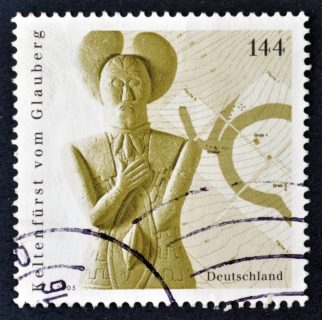Searching for traces on Celtic statues: The Glauberg prince
FAU researchers use digital technology to investigate traces left by tools on 2400 year old statues
One meter eighty in height, armor reminiscent of the Greek army, a Celtic shield in his hand and on his head a decorated helmet that some might say looks like Mickey Mouse ears: when the Glauberg Price was excavated 26 years ago, the sculpture was a true sensation. It was the first time that opulent early Celtic graves were found in a large communal burial ground in Hessen. Among the discoveries was the sandstone statue representing a warrior or high-ranking person. A research team from FAU and the Czech Jan-Evangelista-Purkyně University in Ústi nad Labem have inspected the statue and fragments of two other statues for any traces indicating how they were made. The results of the investigations have now been published in the journal Plos One under the title “Sculpting the Glauberg ‘Prince’. A traceological research of the Celtic sculpture and related fragments from the Glauberg (Hesse, Germany)”.
Sculpture of the Glauberg prince and fragments of two other statues investigated for traces of tool marks
Prof. Dr. Doris Mischka, Chair of Pre- and Protohistory, and her colleagues used several different methods in order to find out which tools the ancient sculptors used, what material their tools were made of and whether any of the techniques they used could indicate where their craftsmanship originated, for example from Northern or Central Italy. They took a close look at the traces left behind on the sandstone surface when the sculptures were made nearly 400 years BCE. The first step involved using mechanoscopy to investigate the mechanic traces left by the tools. “We used what is known as the structure from motion method,” explains Prof. Mischka. Using high-resolution, overlapping photos, the researchers created a detailed 3D model of the statute and the two fragments. “Using these hypsometric 3D models allows us to investigate the longitudinal (lengthwise) and transverse (cross-sectional) traces left by the tools. The transverse section indicates the shape of the tool used, while the longitudinal section reveals the trajectory of the passage of the tool and its dynamics.” In the second step, the research team used X-ray fluorescence measurements (XRF) to investigate the traces left by tools in the stone to find tiny splinters that may have broken off the tool and been left behind in the stone. This allowed the researchers to come to conclusions concerning the form and material of the tools used and narrow down in which phase of creating the statue they were used.
Three phases
“It appears as if there were three phases involved in creating the statues, in each of which different tools were used,” explains Doris Mischka. “In the first phase, a pick was used to sculpt the basic shape. It is hard to say exactly which tool was used in the second phase, during which the shape of the sculpture was further refined. It is possible that the sculptor used an adze usually used for working with wood.” In the third phase, they then used chisels of varying widths. The XRF analysis revealed that the sculptor(s) used tools made of a copper alloy, for example bronze, or iron.
“We were unable to answer the question of whether the Celtic sculptors developed their techniques themselves or whether they used techniques originating from the other side of the Alps,” explains Prof. Mischka. “To do so, we would need to define the methods developed by the sculptor to work with stone. Above all, we would need to identify not only the traces left by particular tools but to concentrate on the individual phases and procedures used to shape the sculpture.”
Further information:
Prof. Dr. Doris Mischka
Chair of Proto- and Prehistory
Phone: +49 9131 85 22408
